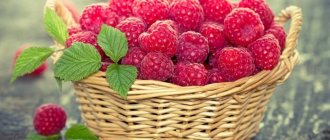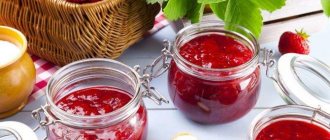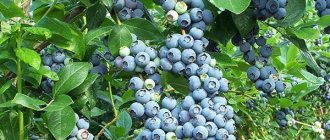The benefits of viburnum have been known for a long time. The berries are used in folk medicine to treat colds. They also have a positive effect on the reproductive system and help normalize hormonal levels. When breastfeeding, it is necessary to take into account that viburnum has a number of contraindications. Therefore, you should study in detail all the properties of the berry in advance.
Benefits for mom
This small berry has a huge supply of useful substances. The therapeutic effect of its use is achieved due to:
- vitamin C;
- gland;
- retinol;
- phosphorus;
- tocopherol;
- phylloquinone;
- organic acids (formic, acetic);
- pectin substances;
- tannins;
- potassium;
- phytoncides.
And this is not a complete list of elements necessary for the body that are found in viburnum. After taking the berries:
- blood vessels are strengthened, the skin becomes more elastic, cell regeneration accelerates. Viburnum is often recommended as a regenerative agent to speed up postoperative recovery. It promotes rapid healing and shortens the recovery period;
- the risk of postpartum hemorrhage is reduced, which sometimes even medications cannot cope with;
- toxins are removed from the mother’s body, and the baby receives additional protection from harmful compounds that can penetrate through breast milk;
- the healing of postpartum injuries to the genital organs and cracks in the chest is accelerated. To do this, apply compresses with viburnum juice to the affected areas;
- metabolism is normalized and the quality of breast milk improves;
- swelling disappears, blood pressure decreases, body temperature normalizes due to the mild diuretic properties of the berry.
During breastfeeding, viburnum should be used as a diuretic with caution, because Excessive fluid excretion can cause a lactation crisis. In moderate quantities, the berry, on the contrary, improves milk production during breastfeeding and is used as an analgesic for various pains.
Not only viburnum berries have beneficial properties. In addition to the fruits, I add plant flowers to decoctions and syrups that increase appetite and heal the vocal cords. The juice relieves inflammation, stimulates the sweat glands, and heals wounds.
Compresses with a decoction of viburnum leaves are used for skin inflammation. They are used for acne and lichen. The tree bark is infused with alcohol, boiled and extracted. The resulting solutions have anti-inflammatory and regenerating effects.
Can a nursing mother eat berries?
There is an opinion that berries are a highly allergenic product, fortunately this is not the case. Berries must be included in the diet of a nursing mother . They contain vitamins that help the body restore strength, strengthen the immune system and regulate digestion. They taste sweet and juicy, and a young mother really misses such a delicacy during a diet.
Important! Berries should be consumed with caution. Some of them can cause food allergies.
Types of product that are acceptable during lactation
Berries are useful both fresh and dried or frozen . Doctors recommend consuming them strictly in season, not eating early berries, as this can cause allergies in the baby or intestinal upset in the mother. Which berries are allowed and which are not?
- Viburnum is full of useful components and has a wide range of effects on the body during breastfeeding. Viburnum has preventive properties, strengthens the immune system, removes harmful substances from the body, normalizes metabolism and, most importantly, accelerates the process of restoration of the female reproductive system.
- Chokeberry - this type of berry very rarely causes allergies, including during breastfeeding. Full of vitamins, organic acids and minerals. Chokeberry removes toxins, normalizes liver function and blood pressure. Useful for diseases of the skin and urinary system, as well as for visual impairment.
- Cherry - this type of berry helps cope with diseases of the kidneys, lungs, stomach, and also helps restore the body in case of anemia and constipation, and reduces high blood pressure. Cherries contain a large amount of fiber and vitamins, so they are very useful, including during breastfeeding.
- Olives - improves the quality of milk and has a complex of useful elements. They help restore bone tissue, have a beneficial effect on the nervous and cardiovascular systems, strengthen the immune system and stabilize the production of hormones.
- Strawberries are an allergen. Helps with constipation and stimulates intestinal function, lowers blood pressure and strengthens the cardiovascular system.
- Hawthorn - has substances that stimulate the heart. Relieves fatigue, stabilizes blood pressure and strengthens the body. Hawthorn has a different effect on a child; it can cause a malfunction of the cardiovascular system.
- Lingonberries are useful for many vitamins for mother and child; they should not be consumed if you have diseases of the gastrointestinal tract, heart disease, ulcers or blood pressure.
- Grapes are good for the mother, but for the child it is fraught with painful colic due to fermentation in the intestines.
- Cranberry - has a tonic effect on the body and improves lactation. It must be present in the mother’s diet.
- Raspberries are a tasty and healthy berry and a strong allergen. Not recommended during lactation.
- Sea buckthorn - promotes the growth and development of the baby. It also has healing properties during colds.
- Black currant - regulates blood sugar and improves appetite.
- Blueberries are a healthy berry for mother and baby. Normalizes stool, stabilizes metabolism. Allergic reactions are present in 30% of children.
- Rosehip is useful for its ability to strengthen the immune system and fight viruses.
When to turn on power mode?
Berries have a beneficial effect on the body of mother and child and rarely cause allergies. Berries should be introduced into the diet with caution. From what month and how to introduce berries:
- Viburnum is used in the form of infusions, decoctions and juices. If a child is predisposed to allergic reactions, it can be introduced into the mother’s diet only 6 months after birth. The first dose begins with adding berries to tea (7 pieces per 250 ml), preferably in the morning, to observe the baby’s reaction.
- Chokeberry is consumed fresh, dried and baked. You can eat it from 1-2 months after birth, after trying a few berries, if the baby does not have a negative reaction, increase the dose over time.
- cherries into the diet for 2 months after birth, starting with one berry and gradually increasing the dose to 10 berries per day.
- Olives can be eaten from the first month.
- strawberries into the diet no earlier than the third month after childbirth.
- Hawthorn is contraindicated during breastfeeding.
- Lingonberries begin to be introduced into the diet from half of one berry in the third month after birth.
- Grapes are undesirable during lactation.
- Cranberries can be consumed from the third month. Start with 1-3 berries and increase the dose to 15 per day. Also taken in the form of a fruit drink (berry juice is diluted with water 1/1), starting from 0.5 cups to 2 liters per day
- Raspberries are contraindicated during lactation.
- Sea buckthorn juice diluted with water in a 1:1 ratio can be drunk in the second month after childbirth.
- Black currants are recommended to be consumed fresh and with caution, not earlier than from the third month.
- blueberries to 2-3 berries and monitor the baby’s reaction. Possible from the second month.
- Rosehip can be consumed in decoctions, but in small quantities, it will not harm the baby. Reception should begin at 2-3 months.
After each dose, monitor the baby’s reaction. If your child has any negative reaction, stop taking the berries for 1-2 months.
How to use?
Berries can be consumed fresh or dried, as decoctions, compotes or juices diluted half with water. It is advisable to eat berries and make compotes from them in accordance with the season , this applies to:
- strawberries;
- black currant;
- cherries;
- blueberries
Fresh berries can be added to baked goods, cereals and yoghurts. Take viburnum, rose hips and sea buckthorn in the form of special decoctions.
Positive effect on the body
Attention! Berries help mother’s recovery after pregnancy and childbirth and strengthen the immune system.
They are full of useful substances and vitamins, especially such as:
- vitamin C;
- vitamin K;
- B vitamins;
- folacin.
Berries are a low-calorie product, and this is very important for women during lactation . Berries are a storehouse of useful elements that a woman lacks during the postpartum period.
Treatment of colds with viburnum
In terms of ascorbic acid content, viburnum is many times higher than citrus fruits and garden berries. For colds, viburnum is used because of its powerful anti-inflammatory effect. This plant can alleviate the condition even with severe acute respiratory infections or flu.
Viburnum also has other properties necessary in the treatment of colds.
- Antiseptic. Destroys bacteria and inhibits the development of the infectious process.
- Antiviral and immunomodulating. The production of interferons is stimulated and the healing process is accelerated.
- Decongestant and vasoconstrictor. Relieves swelling of the mucous membranes and nasal congestion. Consequently, breathing becomes easier.
- Calming. When taking teas and infusions in the evening, it will be easier to fall asleep and insomnia will not bother you.
- Healing. Viburnum accelerates cell regeneration.
- Restorative. Helps not only with colds, but also in restoring vitality and performance after it.
- Antitussive and expectorant. Berries help with any cold cough.
- Antipyretic. The diaphoretic and diuretic effect of the plant helps with this.
Treatment of colds in a nursing mother is complicated by the fact that not all medications are approved for use. Viburnum is an excellent antiviral agent during lactation, created by nature itself.
Viburnum during pregnancy
The healing qualities of this crop are diverse and concentrated not only in the berries, but also in the following parts:
- flowers;
- leaves;
- roots;
- bark;
- fruit seeds.
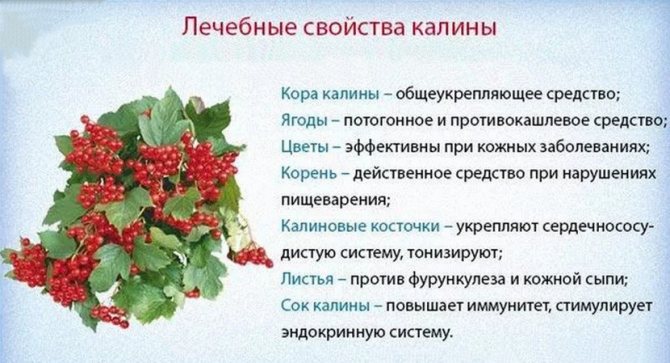
This allows viburnum to be useful in treating:
- swelling;
- stomach ulcer;
- hypertension;
- gastritis;
- bronchial asthma;
- tumors;
- cough;
- constipation
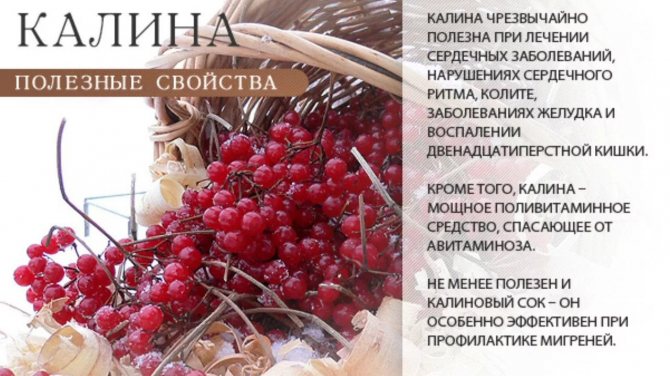
The medicinal properties of this plant are due to the presence of a rich and well-balanced composition of nutrients.
| Vitamins: | Macro- and microelements: |
| retinol (A) | iron |
| folic acid (B9) | potassium |
| ascorbic acid (C) | magnesium |
| alpha tocopherol (E) | iodine |
| phylloquinone (K) | calcium |
| nicotinic acid (PP) | sodium |
| organic acid | phosphorus |
| iron salt | zinc |
| essential oil | chlorine |
In addition, the plant is rich in:
- invert sugar;
- tannins;
- pectins;
- alkaloids;
- flavonoids;
- amino acids;
- phytosterols;
- organic acids;
- fatty acids;
- steroids;
- coumarins.
The energy value of viburnum is 26.3 kcal per 100 g of product. In the complete absence of proteins and fats, the same amount of plant berries contains 7.1 g of carbohydrates.
Did you know? Since ancient times, viburnum has been considered a female tree. Being a symbol of girlish beauty, she was an invariable attribute of weddings in Rus', and for older women she was a silent listener with whom they shared their sorrows.
Benefit
- The plant under discussion helps fight the diseases listed above with the help of its following properties:
- anti-inflammatory;
- bactericidal;
- sweatshops;
- antipyretics;
- diuretics;
- antihypertensive;
- anticonvulsants;
- sedatives;
- hemostatic.
At the same time, the presence of iron in the red berry is especially important for pregnant women, of which it contains 5 times more than in other fruits. The deficiency of hemoglobin in the blood observed in expectant mothers in most cases is quite easily eliminated by consuming viburnum berries.
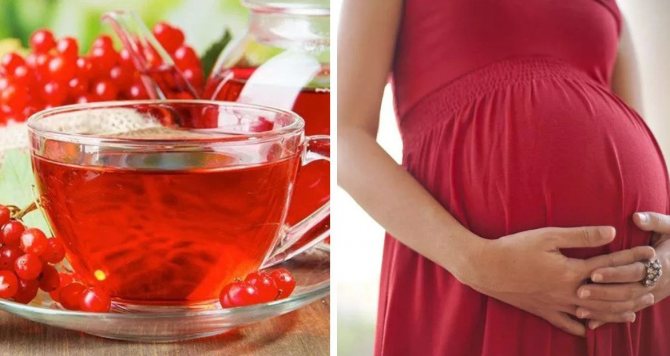
And the bark of this plant successfully stops uterine bleeding, which can be useful not only during pregnancy, but also in the postpartum period. In addition, these fruits are able to fight toxicosis at the beginning of pregnancy and facilitate the birth process at the end of it.
Harm
The property of viburnum to activate uterine activity, so useful during the birth process, has its downside in the middle of pregnancy. This ability of the berry can increase the activity of the uterus so much that there is a serious risk of miscarriage.
Important! The variety of properties of viburnum requires expectant mothers to consult a doctor before consuming this product in order to avoid undesirable consequences.
In pregnant women with low blood pressure, viburnum fruits can aggravate the situation. It is also not recommended to use them for women who have increased blood clotting and a tendency to thrombosis, since this plant has the ability to thicken the blood.
- Viburnum products are also contraindicated for:
- their individual intolerance;
- kidney problems;
- gastric diseases associated with high acidity;
- arthritis.
Contraindications for use
Viburnum is not recommended for use in some cases. It is highly undesirable for women to consume the plant if they have:
- hypotension;
- thrombophilia;
- deviations in the functioning of the circulatory system;
- gastrointestinal diseases that cause increased acidity of gastric juice;
- secondary kidney diseases;
- gout;
- allergies to viburnum;
- stones in the kidneys or other organs of the urinary system;
- arthritis.
It is necessary to approach the issue of taking viburnum with extreme caution if a child has frequent allergies. In the absence of contraindications, the consumption of berries is allowed for nursing mothers, but within reasonable limits.
Where is the best place to buy viburnum and how to choose a quality product?
Viburnum can be used fresh, frozen or dried. Accordingly, you can purchase it in different ways.
The safest fruits can be collected independently in the forest. For many people, this tree grows in their dacha. In these cases, questions will not arise about the quality of the product and its environmental friendliness. But what if there is no such opportunity?
You can look for dried fruits in the pharmacy, but they are not as common as you would like. More often, pharmacists offer viburnum syrup. Frozen fruits are available on supermarket shelves. In order not to make a mistake with the quality of the product, you should choose well-known and proven brands of goods.
If preference is given to fresh years, then you need to look for them on market stalls after the first frost. Late October – early November. It is at this time that the fruits gain more nutrients.
Berries in any form are offered by online pharmacies and stores. When ordering online, it is better to give preference to dried fruits, since they have a longer shelf life and are not so demanding in terms of storage and transportation conditions.
In what form is it best for a nursing mother to consume berries?
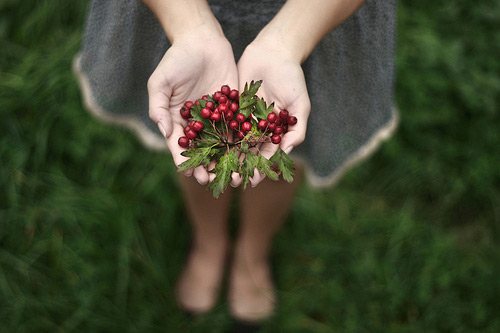
Fresh viburnum is not suitable for starting when breastfeeding. It contains the largest amount of substances that can cause allergies in a baby.
In viburnum, pureed with sugar, syrup or jam, all the beneficial properties of the berry are also preserved. Both options are allowed during lactation. But in addition to the fact that the baby has a risk of developing an allergy to viburnum, there is an increased likelihood of developing diathesis. Therefore, viburnum in such forms should be introduced into the diet in small portions and gradually.
The safest way to consume viburnum while breastfeeding is a weakly concentrated compote, fruit drink or tea with the addition of berries . Fruits processed in this way contain all useful components, but their concentration is practically incapable of harming the baby.
Rules for using berries for breastfeeding
Lactating women are allowed to try viburnum for the first time when the child is 3 months old. If a newborn is allergic to it, then the product can be consumed only 6 months after birth.
During breastfeeding, you should adhere to the following rules:
- It is strongly recommended not to consume fresh berries immediately, as this increases the likelihood of highly concentrated allergic substances entering the milk.
- For the first time, it is better to try boiled viburnum. Then the berries are added to the decoction or compote in the proportion of 10 pieces per 300 ml of water.
- Over time, the number of fruits increases, the main thing is to do this gradually. If the baby does not have a negative reaction, then you can try fresh viburnum.
- At first (2 – 3 days) the plant is eaten only in the morning or afternoon. This is necessary to monitor the condition of the baby and notice an allergic reaction in time (redness, rash on the skin, itching, peeling, etc.). In addition, after consuming a new product, there is a possibility of increased sweating, red cheeks, or restlessness in the child.
- Lactating women are allowed to eat viburnum once every 7 days.
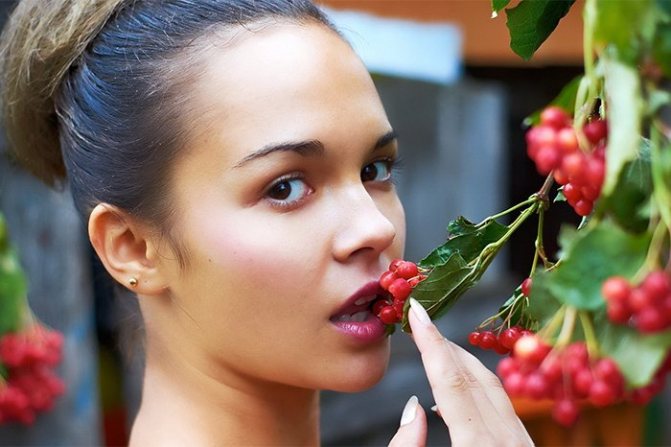
If the mother and baby do not have intolerance to the components of the berries, then it can be consumed during breastfeeding. The fruits can be added to tea, fruit drinks, or made into compote. It is recommended to drink warm viburnum drinks, as they improve the flow of milk and its composition. With regular use, immunity increases and the body becomes resistant to infectious diseases.
Thus, viburnum during breastfeeding is a product whose benefits can hardly be overestimated.
Introduce it into the diet 3 months after birth and monitor the baby’s reaction during use. If there is no allergy, then consume berries once a week, preferably in the form of heat-treated drinks. A doctor will advise you in more detail about the rules for using viburnum in each individual case. Subscribe to our VKontakte group
How to properly introduce berries into your diet?
It is advisable to start taking viburnum when the baby outgrows three months of age. If after the first dose the child has an allergic reaction, then there is no need to continue experimenting with this berry. You should postpone this product until a later period and try to reintroduce it into the diet after another 3 months.
Taking viburnum or products made from it while breastfeeding should be in accordance with certain rules:
- You should not start with fresh berries, because... the concentration of substances that can provoke allergies is much greater;
- For the first time, a weakly concentrated viburnum compote is suitable. It is prepared at the rate of 10 berries per 2.5 glasses of water;
- The number of fruits in the decoction is gradually increased and the baby’s reaction is observed. If allergies do not occur, you can try fresh berries.
When introducing viburnum into the diet, you need to consume it in the morning or afternoon. This will help to detect a negative reaction of the baby (if any) in time. Rashes, itching, peeling, increased sweating, reddened cheeks or other ailments should alert you.
It is not recommended to eat berries more than once a week.
Features of using viburnum during lactation
The list of products allowed during breastfeeding also includes viburnum. A decoction or infusion of these berries in small quantities can be consumed by a nursing mother if the newborn has no negative reactions.
Pediatricians recommend introducing viburnum into the diet no earlier than 3 months after birth. If the baby has a predisposition to allergic reactions or diathesis, the introduction of berries into the diet of a nursing mother is allowed only when the child reaches 5-6 months.
Nutritionists and pediatricians during lactation recommend:
- Do not eat fresh berries, since allergens may enter breast milk in increased concentrations.
- For the first time, use no more than 10 berries for food, adding them to tea or compote when boiling. The liquid is taken in a volume of 250 ml.
- If negative reactions are not observed in the baby, gradually increase the amount of berries, try introducing fresh berries, as well as viburnum juice, into your diet.
- For the first 2-3 days, viburnum berries, like any new product, must be consumed in the first half of the day. This way you can promptly notice negative reactions in your baby in the form of skin rash, itching, etc. and monitor his well-being.
- Viburnum and dishes based on it can be consumed during breastfeeding no more than once a week.
Decoctions and tea with viburnum in large quantities can provoke a lactation crisis, as the berries increase the removal of fluid from the body!
Viburnum-based recipes for young mothers
Tea
To prepare viburnum tea, you can use berries that have been previously pureed with sugar. A couple of teaspoons of the mixture are poured with boiling water and after a few minutes the drink is ready to drink.
You can also add viburnum juice in small quantities to the brew and drink it like regular tea.
For another method of brewing a tea drink, both fresh and dried berries are suitable. Several fruits are poured with boiling water and infused. The result is a very tasty and healthy drink, to which you can add a little sugar if desired.
Jam
Viburnum makes very tasty jam. It is advisable to prepare it from fresh berries, but frozen ones are also suitable. For 1 kg of fruit you will need 200 ml of water and 800 g. Sahara.
The berries are placed in the oven until evaporated at a temperature of 170 degrees. Soft fruits are filled with pre-cooked hot syrup from sugar and water. The jam is boiled, then cooled and adjusted for at least 8 hours, then cooked again. If you add a teaspoon of this delicacy to a cup with 200 ml of water, you will get an excellent fruit drink, which is so useful for nursing women.

